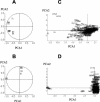Coordinated regulation of genes for secretion in tobacco at late developmental stages: association with resistance against oomycetes
- PMID: 14764907
- PMCID: PMC344560
- DOI: 10.1104/pp.103.034173
Coordinated regulation of genes for secretion in tobacco at late developmental stages: association with resistance against oomycetes
Abstract
Besides the systemic acquired resistance (SAR) induced in response to microbial stimulation, host plants may also acquire resistance to pathogens in response to endogenous stimuli associated with their own development. In tobacco (Nicotiana tabacum), the vegetative-to-flowering transition comes along with a susceptibility-to-resistance transition to the causal agent of black shank disease, the oomycete Phytophthora parasitica. This resistance affects infection effectiveness and hyphal expansion and is associated with extracellular accumulation of a cytotoxic activity that provokes in vitro cell death of P. parasitica zoospores. As a strategy to determine the extracellular events important for restriction of pathogen growth, we screened the tobacco genome for genes encoding secreted or membrane-bound proteins expressed in leaves of flowering plants. Using a signal sequence trap approach in yeast (Saccharomyces cerevisiae), 298 clones were selected that appear to encode for apoplastic, cell wall, or membrane-bound proteins involved in stress response, in plant defense, or in cell wall modifications. Microarray and northern-blot analyses revealed that, at late developmental stages, leaves were characterized by the coordinate up-regulation of genes involved in SAR and in peroxidative cross-linking of structural proteins to cell wall. This suggests the potential involvement of these genes in extracellular events that govern the expression of developmental resistance. The analysis of the influence of salicylic acid on mRNA accumulation also indicates a more complex network for regulation of gene expression at a later stage of tobacco development than during SAR. Further characterization of these genes will permit the formulation of hypotheses to explain resistance and to establish the connection with development.
Figures



Similar articles
-
Homologous RXLR effectors from Hyaloperonospora arabidopsidis and Phytophthora sojae suppress immunity in distantly related plants.Plant J. 2012 Dec;72(6):882-93. doi: 10.1111/j.1365-313X.2012.05079.x. Epub 2012 Oct 26. Plant J. 2012. PMID: 22709376
-
Silencing of acidic pathogenesis-related PR-1 genes increases extracellular beta-(1->3)-glucanase activity at the onset of tobacco defence reactions.J Exp Bot. 2008;59(6):1225-39. doi: 10.1093/jxb/ern044. Epub 2008 Apr 4. J Exp Bot. 2008. PMID: 18390849
-
RNase activity prevents the growth of a fungal pathogen in tobacco leaves and increases upon induction of systemic acquired resistance with elicitin.Plant Physiol. 1997 Dec;115(4):1557-67. doi: 10.1104/pp.115.4.1557. Plant Physiol. 1997. PMID: 9414563 Free PMC article.
-
Nonhost resistance to Phytophthora: novel prospects for a classical problem.Curr Opin Plant Biol. 2001 Aug;4(4):295-300. doi: 10.1016/s1369-5266(00)00176-x. Curr Opin Plant Biol. 2001. PMID: 11418338 Review.
-
Elicitins from Phytophthora and basic resistance in tobacco.Proc Natl Acad Sci U S A. 1995 May 9;92(10):4088-94. doi: 10.1073/pnas.92.10.4088. Proc Natl Acad Sci U S A. 1995. PMID: 7753775 Free PMC article. Review.
Cited by
-
Natural SNP Variation in GbOSM1 Promotor Enhances Verticillium Wilt Resistance in Cotton.Adv Sci (Weinh). 2024 Dec;11(45):e2406522. doi: 10.1002/advs.202406522. Epub 2024 Oct 16. Adv Sci (Weinh). 2024. PMID: 39413014 Free PMC article.
-
The lysin motif-containing proteins, Lyp1, Lyk7 and LysMe3, play important roles in chitin perception and defense against Verticillium dahliae in cotton.BMC Plant Biol. 2017 Sep 4;17(1):148. doi: 10.1186/s12870-017-1096-1. BMC Plant Biol. 2017. PMID: 28870172 Free PMC article.
-
Root secretion of defense-related proteins is development-dependent and correlated with flowering time.J Biol Chem. 2010 Oct 1;285(40):30654-65. doi: 10.1074/jbc.M110.119040. Epub 2010 Aug 3. J Biol Chem. 2010. PMID: 20682788 Free PMC article.
-
Comparative transcriptome profiling of potato cultivars infected by late blight pathogen Phytophthora infestans: Diversity of quantitative and qualitative responses.Genomics. 2023 Sep;115(5):110678. doi: 10.1016/j.ygeno.2023.110678. Epub 2023 Jul 3. Genomics. 2023. PMID: 37406973 Free PMC article.
-
The Thioredoxin GbNRX1 Plays a Crucial Role in Homeostasis of Apoplastic Reactive Oxygen Species in Response to Verticillium dahliae Infection in Cotton.Plant Physiol. 2016 Apr;170(4):2392-406. doi: 10.1104/pp.15.01930. Epub 2016 Feb 11. Plant Physiol. 2016. PMID: 26869704 Free PMC article.
References
-
- Abad A, Cardin L, Poupet A, Ponchet M (1989) Comparison of pathogenesis related “b1” protein determination obtained by Elisa and HPLC techniques. J Phytopathol 124: 175–188
-
- Abad LR, D'Urzo MP, Liu D, Narasimhan ML, Reuveni M, Zhu J, Niu X, Singh NK, Hasegawa PM, Bressan RA (1996) Antifungal activity of tobacco osmotin has specificity and involves plasma membrane permeabilization. Plant Sci 118: 11–23
-
- Abedon BG, Tracy WF (1996) Congrass1 of maize (Zea mays L.) delays development of adult plant resistance to common rust (Puccinia sorgi Schw) and European corn borer (Ostrinia nubilalis Hubner). J Hered 87: 219–223
Publication types
MeSH terms
Substances
LinkOut - more resources
Full Text Sources
Other Literature Sources
Research Materials
Miscellaneous

